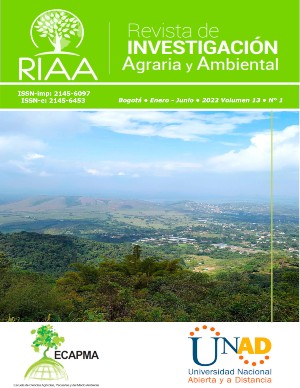Derechos de autor 2021 Revista de Investigación Agraria y Ambiental
 Cuando RIAA recibe la postulación de un original por parte de su autor, ya sea a través de correo electrónico o postal, considera que puede publicarse en formatos físicos y/o electrónicos y facilitar su inclusión en bases de datos, hemerotecas y demás sistemas y procesos de indexación. RIAA autoriza la reproducción y citación del material de la revista, siempre y cuando se indique de manera explícita el nombre de la revista, los autores, el título del artículo, volumen, número y páginas. Las ideas y conceptos expresados en los artículos son responsabilidad de los autores y en ningún caso reflejan las políticas institucionales de la UNAD
Cuando RIAA recibe la postulación de un original por parte de su autor, ya sea a través de correo electrónico o postal, considera que puede publicarse en formatos físicos y/o electrónicos y facilitar su inclusión en bases de datos, hemerotecas y demás sistemas y procesos de indexación. RIAA autoriza la reproducción y citación del material de la revista, siempre y cuando se indique de manera explícita el nombre de la revista, los autores, el título del artículo, volumen, número y páginas. Las ideas y conceptos expresados en los artículos son responsabilidad de los autores y en ningún caso reflejan las políticas institucionales de la UNAD
Aplicación de urea, DAP y KCL sobre almácigos de café (Coffea arabica L.) de la variedad Castillo
Contextualización: en el sistema productivo del café, la etapa de almácigo o semillero se constituye como determinante del éxito para la implementación y comportamiento del cultivo. En esta etapa, la nutrición es un factor muy relevante.
Vacío de conocimiento: la utilización de sustratos de diversas procedencias para la implementación de almácigos en el café dificulta un correcto diagnóstico de fertilidad. Por esta razón, la nutrición en esta fase del sistema productivo se basa en recomendaciones y fórmulas generalizadas que no consideran las necesidades diferenciales de las variedades de café empleadas y su estado al momento del trasplante.
Propósito: el objetivo de esta investigación fue evaluar el efecto de los fertilizantes Urea, DAP, KCl y mezclas de estas sobre el crecimiento de plántulas de café (variedad Castillo) durante la etapa de almácigo.
Metodología: este trabajo se realizó en el año 2019 en la granja “La Quinta”, del municipio de Consacá (Nariño-Colombia), a 1.650msnm, bajo un Diseño Completamente al Azar con ocho tratamientos y ocho repeticiones, así: 2,17g de Urea + 0,7g de DAP; 4,3 g de DAP; 3,3 g de KCl; 0,6 g de Urea + 4,3 g de DAP; 2,1 g de Urea + 3,3 g de KCl; 4,3 g de DAP + 3,3 g de KCl; 2,1 g de Urea + 4,3 g de DAP + 3,3 g de KCl y un testigo al que no se le aplicaron tratamientos. Se realizó un análisis de varianza con las siguientes variables: altura de planta, número de hojas, peso seco y fresco de las plántulas, además de un análisis de crecimiento funcional con evaluaciones quincenales.
Resultados y conclusiones: el tratamiento con DAP presentó la mayor altura (20,65 cm), mayor peso fresco y seco de tallo (3,86 g; 1,43 g), mayor peso seco total (5,33 g), mayor área foliar (350,8 cm2) e índice de área foliar (0,99). El tratamiento con Urea + DAP mostró la mejor tasa de asimilación neta (0,00029 g- cm-2 d-1) y mejor tasa de crecimiento del cultivo (2,87_e-05 g- cm-2 d-1). El tratamiento con DAP + KCl alcanzó el mayor valor para tasa de crecimiento relativa (0,047 g-1 d-1). En todos los casos se demostró que, para la fase de almacigo, el fósforo se tornó concluyente, debido a que su presencia se relacionó con comportamientos fisiológicos superiores.
Derechos de autor 2021 Revista de Investigación Agraria y Ambiental
 Cuando RIAA recibe la postulación de un original por parte de su autor, ya sea a través de correo electrónico o postal, considera que puede publicarse en formatos físicos y/o electrónicos y facilitar su inclusión en bases de datos, hemerotecas y demás sistemas y procesos de indexación. RIAA autoriza la reproducción y citación del material de la revista, siempre y cuando se indique de manera explícita el nombre de la revista, los autores, el título del artículo, volumen, número y páginas. Las ideas y conceptos expresados en los artículos son responsabilidad de los autores y en ningún caso reflejan las políticas institucionales de la UNAD
Cuando RIAA recibe la postulación de un original por parte de su autor, ya sea a través de correo electrónico o postal, considera que puede publicarse en formatos físicos y/o electrónicos y facilitar su inclusión en bases de datos, hemerotecas y demás sistemas y procesos de indexación. RIAA autoriza la reproducción y citación del material de la revista, siempre y cuando se indique de manera explícita el nombre de la revista, los autores, el título del artículo, volumen, número y páginas. Las ideas y conceptos expresados en los artículos son responsabilidad de los autores y en ningún caso reflejan las políticas institucionales de la UNAD








